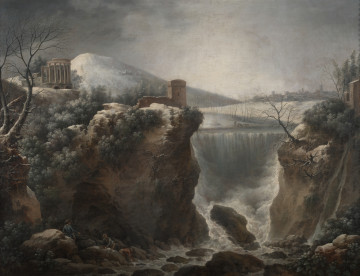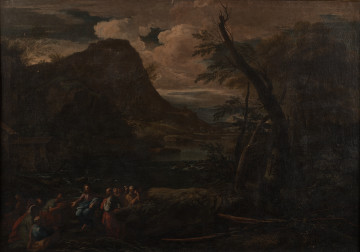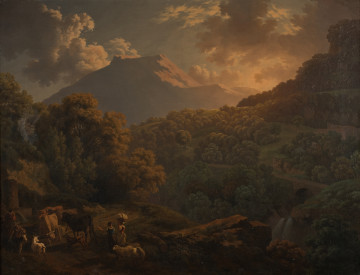
Winter landscape with ruins and a stream
18th century
Castle Museum in Łańcut
Part of the collection: Malarstwo i rysunek
Painting donated to the Łańcut Castle and depicting a port illuminated by moonlight and enlivened by a set of small human figures – fishermen busy with fishing and a group of people warming themselves by a bonfire on the quay. The source of light is the full moon hanging low over the horizon, resulting in silvery reflections on the water. Bonfire is another, local, source of light, it is illuminating human silhouettes with golden-red reflections. The sea is calm, there is a lighthouse rising on the right side. The painting was created in 1774 by Claude Joseph Vernet (born August 1714 in Avignon, died December 1789 in Paris), a French painter and engraver working during the Classicist period. He used to paint landscapes and marine scenes and was called the “moon painter” because he was fascinated by the moonlight. He came from an artistic family, his father was a painter, as were his son and grandson. He studied in Rome, in the studio of Giovanni Pannini, and on his return to France he was counted among the members of the Royal Academy of Painting and Sculpture. He is best known for his series of 24 paintings depicting the ports of France, which he painted for King Louis XV. The painting in question, framed in a wooden, gilded, moulded frame with palmettes and acanthus leaf tendrils at the corners, is exhibited in the Corner Room on the first floor of the castle. On the lower slat of the frame, there is a plaque with details on the painting.
Author / creator
Dimensions
height: 112 cm, width: 162 cm
Object type
Painting and drawing
Technique
oil
Material
wood, canvas
Origin / acquisition method
przekaz
Creation time / dating
Creation / finding place
Owner
Castle Museum in Łańcut
Identification number
Location / status

18th century
Castle Museum in Łańcut

17th century
Castle Museum in Łańcut

18th century
Castle Museum in Łańcut
DISCOVER this TOPIC
National Museum in Szczecin
DISCOVER this PATH
Educational path